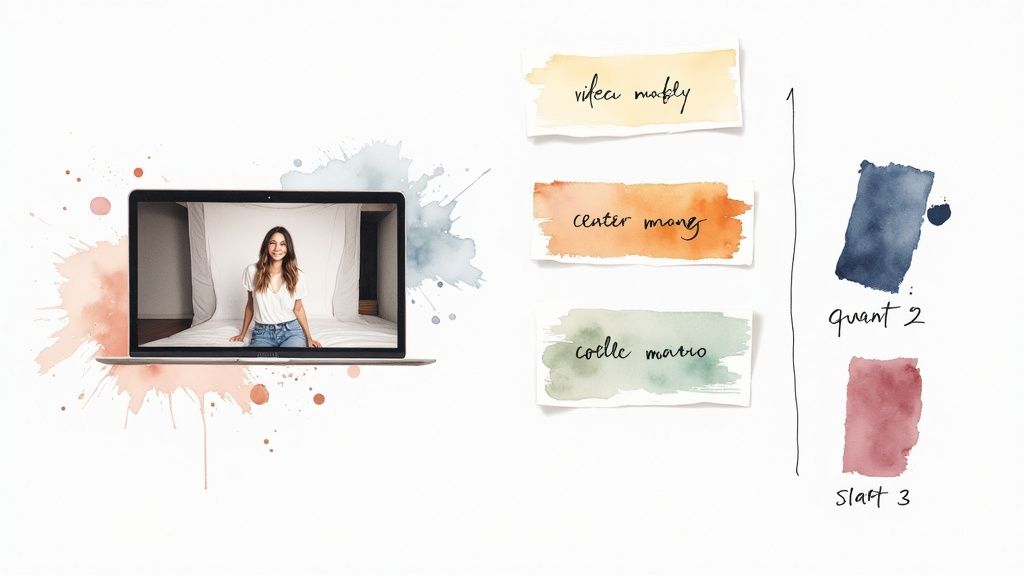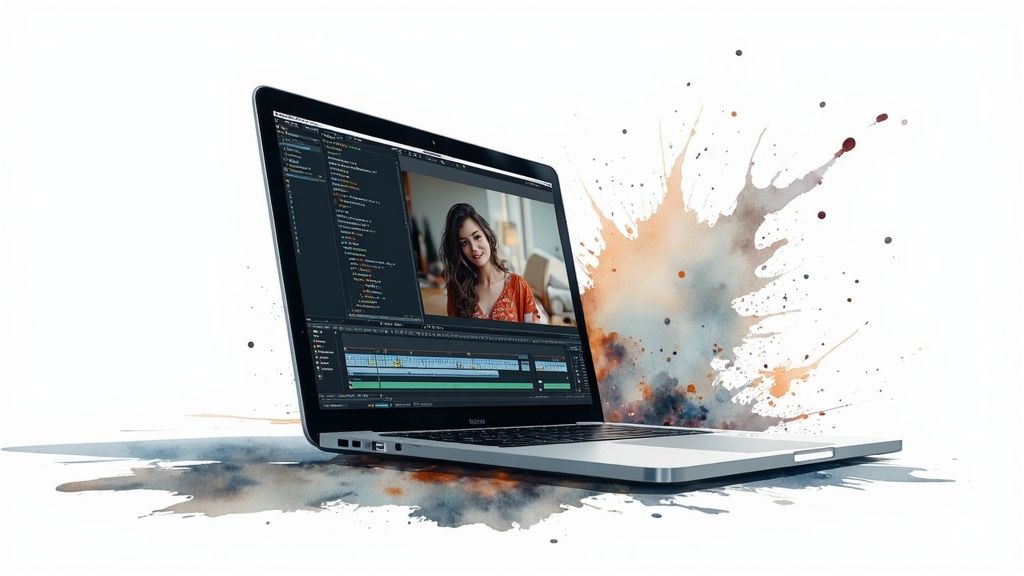Why Text Overlay on Video Is Non-Negotiable Today

Video content reigns supreme in our current media landscape. But simply producing videos isn't enough. Truly connecting with your audience requires a strategic approach, and text overlays play a vital role. They’ve evolved from a stylistic choice to a fundamental necessity.
The way we consume video content has dramatically shifted towards silent viewing. Consider your own social media habits: how often do you actually turn the sound on? Most videos autoplay silently, meaning without text overlays, your message goes unheard.
The Sound of Silence: Why Text Matters
This silent viewing trend presents a crucial challenge for content creators. How do you communicate effectively when your audience can't hear you? The solution lies in the strategic implementation of text overlays. They deliver key information, essential context, and compelling calls to action, even when the audio is off.
The importance of this practice is underscored by the fact that 88% of Facebook users watch videos without sound. This highlights the crucial role of text overlays in maintaining audience engagement. This trend isn’t limited to Facebook; it's prevalent across various social media platforms. Captions and text overlays ensure your message resonates, regardless of audio settings. This not only improves accessibility but also boosts viewer retention and engagement metrics. For a deeper dive into the statistics, check out this resource: Using Text Overlays in Social Videos. Also, you might find this helpful: How to Overlay a Video: Easy Step-by-Step Guide.
Beyond Captions: Different Types of Text Overlays
Text overlays encompass more than just captions. Various types serve distinct purposes:
-
Captions: These transcribe the spoken audio, making your content accessible to a wider audience, including those with hearing impairments.
-
Titles and Headings: Introduce topics, sections, or key points within your video, allowing viewers to quickly grasp the content.
-
Callouts: Highlight key takeaways, special offers, or calls to action, prompting viewers to engage further.
-
Lower Thirds: Display the speaker's name and title, adding context and credibility.
Real-World Impact: Text Overlays in Action
Imagine a cooking video showcasing a delicious recipe. Without text overlays, viewers miss crucial ingredient lists and instructions. But with clear, concise text on screen, even silent viewers can easily follow along. This enhances viewer satisfaction and engagement. Similarly, in a product demo video, highlighting key features and benefits with text overlays can significantly boost conversion rates, even if viewers don’t activate the audio. This demonstrates how text overlays drive viewer behavior and amplify overall engagement.
Crafting Text Overlays That Command Attention

Captions are just the beginning. Let's delve into crafting text overlays that truly elevate your videos. These overlays should complement, not compete with, your message. By understanding effective text design principles, we can create visuals that grab and keep viewers engaged.
The Psychology of Effective Text Overlays
Effective text overlays use design principles to guide the viewer's attention and reinforce your message. Think of text overlays as visual anchors, adding context and clarity in our fast-paced world. Strategically placed text can highlight a product in a demo or emphasize a key takeaway during a presentation. This helps viewers absorb and retain information more effectively.
Typography and color also play crucial roles. Like the tone of written content, your chosen font contributes to your brand's voice. Color psychology adds another layer, as certain colors evoke specific emotions. A vibrant red might convey urgency, while a calming blue fosters trust. Learn more about creating engaging text overlays in this guide.
The impact of text overlays on viewer retention is significant. When videos include text overlays, there's an 80% chance viewers will focus on them, boosting message retention. This is important because viewers retain 95% of a message when watching a video, compared to just 10% when reading it. Adding text overlays ensures key information is delivered and remembered. More video statistics can be found here.
Typography and Brand Voice: Making the Right Impression
Font choice is crucial. A playful script might suit a lifestyle blog, while a bold sans-serif projects professionalism for a corporate setting. Consistent font use strengthens brand recognition, creating a visual identity associated with your content.
Color Psychology: Evoking Emotion Through Design
Color psychology is a powerful tool. Warm colors (red, orange) create excitement, while cool colors (blue, green) have a calming effect. Prioritize contrast. Your text should stand out against the background for optimal readability.
The table below offers a guide to selecting the right font for your text overlay:
This table helps creators choose the right fonts for different video contexts and platforms.
| Font Type | Best Use Cases | Platforms | Examples | Considerations |
|---|---|---|---|---|
| Serif (e.g., Times New Roman, Georgia) | Formal videos, documentaries, educational content | YouTube, Vimeo, websites | News reports, explainer videos | Conveys tradition, authority, and trustworthiness |
| Sans-serif (e.g., Arial, Helvetica, Open Sans) | Modern, clean videos, corporate presentations, website overlays | All platforms | Product demos, social media videos | Conveys simplicity, clarity, and modernity |
| Script (e.g., Pacifico, Lobster) | Lifestyle blogs, invitations, creative projects | Instagram, TikTok, websites | Vlogs, promotional videos | Conveys elegance, creativity, and personality |
| Decorative (e.g., Impact, Playfair Display) | Titles, headings, short text overlays | All platforms | Intros, outros, calls to action | Eye-catching but use sparingly for readability |
Key takeaway: While a wide variety of fonts are available, choose one that aligns with your brand and video's purpose.
Positioning for Impact: Guiding the Viewer's Eye
Text placement should be strategic. Avoid cluttering the center, which obstructs the main visuals. Place text in the upper or lower thirds of the frame to guide the viewer's eye.
Readability Across Devices: Ensuring Your Message Reaches Everyone
Optimizing text for various screen sizes is essential. Ensure text is legible on mobile devices. Avoid complex fonts that might pixelate on smaller screens. This ensures your message is clear and accessible, regardless of viewing device. This guide offers further insights.
Before & After: Real-World Transformations
Many creators see improved engagement after implementing strategic text design. One creator saw a 20% increase in watch time after simplifying their font and optimizing text placement. These examples highlight the tangible impact of effective text overlays.
By mastering these techniques, your text overlays become powerful tools, enhancing your video’s impact and resonating with your audience.
Text Overlay Tools Worth Your Time (And Budget)

Adding text to your videos is essential for grabbing attention and conveying information clearly. But with so many tools available, finding the right one can feel overwhelming. This guide breaks down the best text overlay software, considering both your budget and your skill level.
Free vs. Paid: Finding the Right Balance
For beginners or quick edits, free tools offer a solid foundation. YouTube Studio and iMovie are great for adding basic text, perfect for simple projects and learning the ropes. These options provide a valuable entry point for anyone new to video editing.
However, if you're aiming for professional-grade videos, paid software offers a wealth of advanced features. Think custom fonts, animations, and sophisticated effects. For instance, Aeon provides automated text-to-video conversion and social media optimization.
Desktop Software: Power and Precision
Desktop software provides powerful features and precise control, perfect for detailed editing. Industry standards like Adobe Premiere Pro and Final Cut Pro offer comprehensive editing suites, but can be challenging to learn.
If you're looking for user-friendly desktop software, Kapwing and Camtasia offer a good balance of power and simplicity. They provide robust text overlay features within an intuitive interface.
Mobile Apps: On-the-Go Editing
Mobile apps offer incredible convenience, letting you edit anytime, anywhere. Apps like InShot and CapCut are excellent for adding quick text overlays to short videos.
For a more robust mobile editing experience, explore apps like LumaFusion and KineMaster. These offer advanced features like multi-track editing and special effects, rivaling some desktop software.
Feature Comparison: Choosing the Best Fit
When choosing your ideal text overlay tool, consider these key features:
- Customization Options: Control over font, color, and sizing is crucial.
- Animation Capabilities: Animated text adds visual interest.
- Ease of Use: An intuitive interface streamlines your workflow.
- Integration Options: Seamless integration with other tools enhances efficiency.
- Pricing: Choose a tool that fits your budget.
This table summarizes the key features of popular text overlay tools:
| Feature | Aeon | Adobe Premiere Pro | Kapwing | InShot |
|---|---|---|---|---|
| Pricing | Paid | Paid | Free & Paid | Free & Paid |
| Platform | Web-Based | Desktop | Web-Based | Mobile |
| Ease of Use | Easy | Advanced | Intermediate | Easy |
| Animation | Yes | Yes | Yes | Basic |
| Templates | Yes | Limited | Yes | Yes |
Budget-Friendly Alternatives: Getting Started Without Breaking the Bank
You don't need expensive software to add text overlays. DaVinci Resolve offers a powerful free version packed with professional-grade editing tools, including robust text overlay features.
Other free and open-source options like OpenShot and Shotcut are great for beginners and those on a budget, providing a solid starting point for experimenting with text overlays.
By considering your needs and exploring the options, you can find the perfect text overlay tool to enhance your videos and achieve your creative vision.
Mastering Text Overlay in Short-Form Video

Short-form video platforms like TikTok, Instagram Reels, and YouTube Shorts have witnessed a surge in popularity. This rise presents unique opportunities and challenges for content creators. Effective text overlays are no longer a bonus but a necessity in this fast-paced environment.
Why Short-Form Video Needs a Different Text Strategy
Short-form video demands immediate engagement. Viewers scroll rapidly, so your content needs to capture attention within seconds. Text overlays act as visual anchors, conveying your message even before the audio begins. A bold headline or an intriguing question can stop a scrolling thumb in its tracks.
Many viewers also engage with short-form content without sound. This makes text overlays critical for comprehension and interaction. They ensure your message gets across regardless of the viewer's audio settings.
Traditional, lengthy text overlays won't work here. They can overwhelm viewers and detract from the visual experience. Concise, impactful wording is key. This recognizes the limited attention spans inherent in short-form video consumption.
Text overlays boost viewer retention and engagement, especially as short-form video gains momentum. Millions engage with short-form content on platforms like TikTok and Instagram Reels. Adding text makes these videos more informative and visually appealing. In fact, 73% of consumers prefer short-form videos when researching products or services, demonstrating the effectiveness of concise, visually appealing content with text overlays. Find more detailed statistics here.
Timing is Everything: Text Pacing for Short Attention Spans
The timing of your text overlay is crucial. Text should appear in sync with the visuals and audio, if present. Too-fast pacing makes it difficult to read, while too-slow pacing loses the viewer's interest. Think of it as a conversation: the text overlay adds context and highlights important points, similar to spoken dialogue.
Character Count: Less is More in the Short-Form World
Brevity is essential in short-form video. Aim for concise text overlays, avoiding long sentences. Every word matters. Overcrowding the screen with text creates visual clutter, making your video difficult to follow.
Animation: Enhancing Engagement Without Distraction
Subtle animation can add engagement. Simple fade-ins, slide-ups, or highlighting draw the viewer's eye without being overwhelming. However, avoid excessive or jarring animations, as these can distract from the video's main message. Animation should enhance, not overpower.
Platform-Specific Best Practices
Each platform has its own nuances. TikTok often utilizes trending sounds and hashtags, which can be incorporated into text overlays for increased discoverability. Reels, on the other hand, often benefit from more polished, aesthetically aligned text styles reflecting Instagram's visual focus. Tailor your text strategy for optimal engagement on each platform.
The following table outlines some platform-specific best practices to help guide your text overlay strategy:
Short-Form Video Text Overlay Best Practices
| Platform | Ideal Character Count | Recommended Display Time | Optimal Placement | Animation Style |
|---|---|---|---|---|
| TikTok | 20-30 | 2-4 seconds | Centered, Bottom | Kinetic, Fun |
| Instagram Reels | 30-40 | 3-5 seconds | Top, Bottom Left | Elegant, Subtle |
| YouTube Shorts | 25-35 | 2-3 seconds | Centered, Bottom Right | Clean, Simple |
This table provides a general guideline. Experimentation is key to finding what resonates best with your audience on each platform. Remember to prioritize clarity and readability.
Scroll-Stopping Openings: First Impressions Matter
The first few seconds of your short-form video are paramount. A strong opening frame with a compelling text overlay instantly grabs attention, encouraging viewers to watch more. Use a clear title, an intriguing question, or a visually appealing graphic with text to hook viewers from the beginning. This can significantly impact whether a viewer scrolls past or engages with your content.
Maintaining Visual Interest: Text Pacing and Placement
Strategic pacing maintains viewer engagement. Break up longer videos with text overlays to introduce new topics, highlight key takeaways, or inject humor. Varying text placement adds visual interest and prevents monotony, keeping the viewing experience dynamic and engaging.
Creating successful short-form video content requires adapting traditional text overlay techniques. By understanding platform nuances and implementing these tips, you can effectively use text overlays to grab attention, deliver your message clearly, and boost engagement.
Text Overlay as Your Accessibility Superpower
Text overlay on video isn't just about boosting engagement. It's about opening your content to a much wider audience by significantly improving accessibility. Smart creators understand this, strategically using text to connect with underserved audiences and enhance overall video performance. This inclusive approach goes beyond simple compliance; it genuinely enhances the viewing experience for everyone.
Captions: More Than Just Subtitles
Closed captions are often viewed as a feature for the hearing impaired, but their benefit extends far beyond that. They're crucial for non-native speakers navigating unfamiliar languages, viewers in noisy environments, and those who prefer to watch videos silently. This significantly expands your potential viewership.
Captions also improve comprehension and information retention. Providing a visual reinforcement of spoken words helps viewers process and remember key details, even when distractions are present.
Styling and Placement: Best Practices for Captions
Effective caption styling isn't just about aesthetics; it directly impacts readability and viewer experience. Choose a clear, easy-to-read font that contrasts well against the video background. Avoid overly decorative fonts or small text sizes, which can strain eyes and hinder comprehension.
Proper caption placement is also essential. The lower third of the screen typically minimizes interference with the main visuals while ensuring captions remain visible. However, be mindful of other on-screen elements, like lower thirds graphics, to avoid overlap and maintain clarity.
A visually busy background might require a semi-transparent backdrop behind the captions for better readability. If critical action happens in the lower third of the frame, temporarily repositioning captions to the upper part of the screen can be a good strategy.
Accurate timing is equally important. Captions should synchronize precisely with the spoken audio. Lagging or rushed captions disrupt the viewing flow and can be frustrating for the audience.
The widespread adoption of captions and text overlays has led to a significant increase in video accessibility. Between 2021 and recent years, caption use has grown by a staggering 572%. This increase is driven by growing awareness of viewer needs and advancements in AI-powered automatic caption generation tools. Adding captions not only benefits viewers with disabilities but also improves affinity, recall, and likeability. Find more detailed statistics here. You might also find this article interesting: AI Captions for Video: Boost Accessibility, Engagement, and SEO.
The Business Case for Accessibility
Beyond the ethical reasons, accessibility makes good business sense. A larger audience reach translates to greater potential for engagement, views, and revenue. When your content caters to everyone, you unlock significant growth opportunities.
Many creators have seen impressive audience growth by embracing accessible design. One gaming channel, for example, saw a 15% increase in subscribers after consistently implementing closed captions. This demonstrates how accessibility can benefit both viewers and creators.
Practical Frameworks for Implementation
Putting these accessibility principles into practice is straightforward. Begin by ensuring all your videos have accurate, well-timed closed captions. Explore tools like Aeon to automate this process and save valuable time and resources.
Regularly audit your video library to ensure existing captions meet accessibility standards. This proactive approach helps identify and address any gaps in your strategy. Actively seek feedback from your audience. This valuable input can inform further refinements and improvements.
Prioritizing accessibility doesn't just broaden your reach. It builds a more inclusive and engaged community around your content, strengthens your brand, and fosters deeper connections with your audience.
Text Animation That Elevates Your Message
Static text on video can feel, well, static. In the world of online video, movement transforms text from simple information into a captivating element of your story. By understanding the techniques employed by successful creators, you can learn to use kinetic typography—or text animation—to strengthen your message, even without professional motion graphics expertise.
Simple Animation, Big Impact
Think of text animation as a subtle dance, gently guiding your viewer's attention. It doesn't require flashy effects. Even small movements can have a significant impact. A simple fade-in, for example, can softly introduce a key takeaway. A subtle slide-up can highlight a new section. These visual cues make it easier for viewers to follow along, especially those watching without sound.
Consider synchronizing your text animation with audio. This creates a pleasing connection between what viewers see and hear. Having text pulse subtly to the rhythm of background music, for instance, can add visual interest without being distracting, reinforcing your message and creating a more immersive experience.
Text Reveals, Audio Sync, and Subtle Movement
Here are a few animation techniques that can elevate your text overlays:
- Attention-Guiding Text Reveals: Gradually reveal text letter by letter, or word by word, to draw the viewer's eye and build anticipation.
- Synchronized Text-to-Audio Displays: Time text animations to match spoken words or music, creating a dynamic visual echo of the audio track.
- Subtle Movement Patterns: Use gentle animations, like fading, pulsing, or slight rotations, to add visual interest without overwhelming the main content.
Imagine a travel vlog where the location name gracefully fades in as the scene changes, or a product demo where key features appear with a smooth slide-up as the narrator mentions them. These subtle touches boost engagement and improve information retention.
Matching Animation Style to Emotional Tone
Just as music sets the mood, different animation styles can convey different emotions. A fast-paced, bouncy animation might suit a lighthearted video. A slow, elegant fade-in works well for a more serious or dramatic piece. Matching animation style to content creates a cohesive and emotionally resonant experience.
Readability First
While animation adds flair, readability is paramount. Choose clear fonts and appropriate text sizes. Ensure sufficient contrast between the text and background. This is especially important with moving text, as readability can be affected by animation speed and style. Follow these guidelines:
- Font Choice: Select clean, easy-to-read fonts, avoiding overly stylized designs.
- Text Size: Use a text size that's legible on various screen sizes.
- Contrast: Maintain high contrast between text and background for clarity.
- Animation Speed: Avoid excessively fast animations that make text difficult to decipher.
Tools and Resources for Easy Animation
Aeon offers easy-to-use tools and templates that simplify adding text animations. Even without animation experience, you can quickly create professional-looking text overlays using Aeon’s intuitive interface and pre-designed animation presets. These resources empower you to experiment with different animation styles and find what works best for your videos.
Measuring Text Overlay Impact Beyond Views
Adding text overlays to your videos isn't just a stylish trend; it's a crucial strategy for boosting audience engagement. But how can you tell if your text overlays are genuinely hitting the mark? Simply counting views only scratches the surface. This section delves into measuring the real impact of text overlays, moving past superficial metrics to understand what truly connects with your viewers.
Beyond Vanity Metrics: Measuring What Matters
While views offer a basic starting point, they don't reveal the complete picture. Are viewers actually sticking around for the entire video? Are they clicking your call to action? These engagement metrics provide much richer insights into your content's performance. For example, a high view count coupled with low watch time might indicate that viewers are clicking away quickly, perhaps due to unclear or uninteresting text overlays.
Different content goals necessitate different metrics. If your primary aim is brand awareness, then impressions and reach become key indicators. If driving sales is your objective, then click-through rates and conversions take center stage. Understanding these nuances allows you to fine-tune your text overlay strategy for specific outcomes.
A/B Testing: Isolating Text Overlay Variables
A/B testing is an invaluable tool for assessing the effectiveness of your text overlays. By creating two versions of a video – one with variation A and another with variation B – you can directly compare their performance. This helps isolate the impact of specific variables like font choice, color, placement, or animation style. For example, you could compare a bold sans-serif font against a decorative script font to see which leads to higher viewer retention.
Platform Analytics: Unveiling Viewer Behavior
Every video platform offers its own unique set of analytics. YouTube provides detailed data on watch time, audience demographics, and traffic sources. TikTok reveals trending sounds and hashtags that resonate with your audience. Instagram offers insights into follower engagement and reach. By understanding these platform-specific analytics, you can uncover valuable patterns in viewer behavior, helping you craft more targeted text overlays that speak directly to your audience's interests.
Setting Benchmarks and Continuous Optimization
Establishing benchmarks gives you a valuable reference point for tracking progress. Analyze your current video performance to identify areas for improvement. For instance, if your average watch time is low, experiment with different text overlay styles to see what resonates. Regularly review your analytics and adjust your strategy accordingly. This iterative process of continuous optimization ensures your text overlays remain effective and captivating.
Case Studies: Learning from Success Stories
Studying the work of successful content creators can offer invaluable insights. Many creators document their strategies for optimizing text overlays through data-driven approaches. Look for examples of how creators have successfully boosted engagement, watch time, and conversions through strategic text overlay use. These case studies provide real-world proof of the power of text overlays in achieving various content objectives.
Measurement Timelines: Evaluating Strategy Effectiveness
Understanding the timeframe for measuring impact is crucial. Short-term metrics like click-through rates and shares can be assessed quickly. However, long-term metrics like brand awareness and audience growth take time to develop. Set specific timeframes for evaluating your strategy, such as measuring the impact of a new text overlay style on watch time over a two-week period.
Combining Quantitative and Qualitative Data
Numbers tell part of the story, but qualitative feedback provides essential context. Encourage comments on your videos and actively engage with your audience. Respond to questions, address concerns, and solicit feedback on your text overlay design. This valuable qualitative data can reveal deeper insights into viewer preferences. For example, a comment might reveal that your text overlay font is difficult to read on mobile devices.
By moving beyond basic view counts and embracing a more holistic measurement approach, you can unlock the true potential of text overlays to engage your audience, achieve your content goals, and amplify your message.
Ready to transform your video content with impactful text overlays? Discover how Aeon can streamline your video creation process and boost audience engagement.